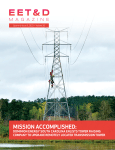The health and modernization of our aging electric grid is a focus for utilities across the U.S. One of the country’s oldest infrastructures, the grid is beginning to show signs of its age across physical components — less able to withstand increasingly frequent and more powerful natural disasters such as wildfires and hurricanes. And with newer power system challenges like those related to the growing adoption of electric vehicles (EVs) and rooftop solar adding further strain, utilities are clear that they need improved visibility of what is happening on their distribution lines.
Advanced line sensing solutions are industry-accepted as one of the most effective ways to gain the real-time distribution system performance and reliability data necessary to meet today’s power delivery demands. These technologies provide fault detection and remote monitoring to multiple locations along overhead and underground lines to reduce outage durations, quickly pinpoint areas for maintenance across thousands of line miles and enable data-driven decisionmaking for reducing operations costs.
While utility leaders may be clear on the benefits of intelligent line sensing, some may not be as clear on the best way to deploy a line sensing initiative. For those who don’t have direct experience rolling out line-sensing projects at their utility, I’ve compiled several recommended steps to help.
What follows are best practices I’ve gathered through many years of experience working with utilities and technology providers on grid modernization pilots and implementation projects.
Step 1: Establish achievable goals
Getting buy-in for a pilot project requires the promise of measurement. Discuss with your stakeholders the types of reliability goals you hope to support with this pilot and be sure that the goals are agreed upon and achievable. To do so, identify your utility’s most pressing grid needs and explain how money and time investments in the pilot project will result in a return on investment. Build this case by referring to the metrics you’ll use to measure the reliability gains (reduced SAIDI, CAIDI, SAIFI) and O&M cost savings.
Step 2: Identify feeders for the pilot
Decide which feeders make the most sense to include in an evaluation pilot. Look at multiple perspectives to help make this decision: age of the line, presence of vegetation, recent outage frequencies, number of customers, patrol challenges for the circuits, reclosers and sectionalizers on the circuit, etc.
Start with at least three to five circuits. This ensures that the pilot can supply meaningful data and serve as a reasonable sample set that is large enough to show potential business impact and whether it makes sense to expand further.
Step 3: Conduct site surveys of potential locations
Once a set of feeders has been identified for piloting, site surveys need to be performed. Check these important elements during the surveys:
- Cellular Signals — With cellular communications, it is important to check signal strength in the field and confirm, via coverage maps, that adequate cellular signal is expected at chosen sites.
- Overhead Sensor Location — Overhead sensors are designed to be installed with a hot stick from a bucket truck. Make sure there are no overgrown trees above the sensors which could prevent receiving GPS and cellular signals and that the sensor LED is visible. Also, ensure conductors are free of debris which could degrade power harvesting.
- Underground Sensor Location — For many utilities, most of their pad-mounted switchgear was deployed decades ago. Cabinet space may be constrained, especially in the case of live-front switchgear. It is important to check the make and model of the cabinet and available space for installing sensors.
- Continuous Loading — Assess average loading expected at the sites and ensure the necessary loading exists for line powering of the sensor.
Step 4: Plan the software installation
Intelligent line sensing solutions include both sensor hardware and software. As the sensor locations are surveyed and studied, start a plan for the software installation.
Weigh the pros and cons of on-premises or cloud-hosted software deployments. Choosing a hosted implementation for the pilot leads to shorter deployment time and fewer IT resources. Also, decide how data will flow and integrate with OT systems. Sensors with dual DNP master capability simplify data integration as they send sensor data to both Ample and a second OT system such as an Advanced Distribution Management System (ADMS).
Step 5: Train staff on sensors and software
Be sure you have a clear point of contact with the solution provider for any technical questions that arise before or during the pilot deployment. While it’s always preferable to have your vendor on-site for training on sensor installation, remote video training is a good alternative and is also effective for software training.
Evaluate and use all training resources made available to you. In addition to training videos, ask for reference resources such as an installation guide with a very detailed walkthrough of installation steps and necessary tools, and condensed one-page quick start cards.
Step 6: Deploy pilot units
For the first pilot configuration, deploy two or three line-sensing solutions at three to five feeders.
Confirm with your vendor how to pre-configure the line sensors as much as possible before installation to make for quicker, easier deployment. Also, confirm how long installations should take, how many utility crew (if any) will be needed and how quickly you’ll begin receiving reports of data from the field.
The recommended duration of a line-sensing pilot is generally from 30 to 60 days.
In addition to an analysis of real events on the chosen circuits, plan to simulate faults to create additional tests for the line sensing system during the pilot.
Actionable data for grid management
Monitoring with intelligent line sensors is one of the most effective ways to gain situational awareness of the control center, and the visibility and actionable data needed to assist planning and reliability groups for better overhead and underground grid management (especially for utilities striving to meet a complex set of power delivery and reliability challenges). Getting started with line sensing is not difficult. By using the steps in this article as a guide you should be able to quickly start a pilot and achieve the benefits of increased system visibility and data firsthand.
In our next article, I’ll go into detail about how to come back and prove ROI from the pilot. I’ll provide a step-by-step guide to show the return on investment from your pilot, with recommendations on how to reprioritize investment areas to achieve more value.

Randy Cough has more than 30 years of electric distribution, operations planning and program management experience related to grid modernization programs for electric utility customers. His primary expertise is in utility control center operations, distribution automation and control center applications such as advanced distribution management systems (ADMS) Outage Management Systems (OMS).
Prior to joining Sentient Energy, Cough worked at GE Energy for 20 years. His experience also includes more than 15 years at Niagara Mohawk Power (now National Grid) as a system electric operations director.







